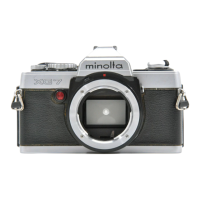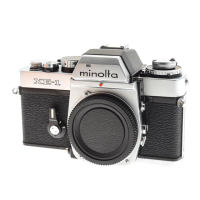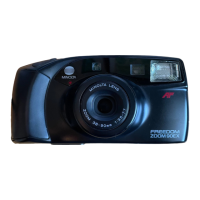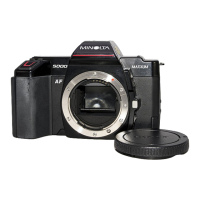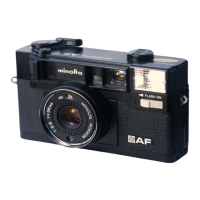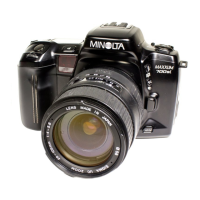spring tension on the spring-hooking
pulley. Too much tension could break the
scale.
You can get just the shutter-speed
scale as a replacement part. Alternately,
you can replace the complete shutter-
speed indicator assembly; the assembly
includes the scale and the pulleys with the
spring already tensioned. There's an ad
vantage in replacing the complete
assembly — if you replace just the scale,
you may encounter tracking and align
ment problems. That is, when you get the
"0" calibration centered in its window,
you may find that the ‘‘1000'' calibration
does not center. However, if the scale
breaks, you can normally make a satisfac
tory repair without replacing parts.
The break usually occurs at the point
where the scale cements to the wire-
hooking pulley. Part of the scale then re
mains cemented in place. Simply butt the
loose end against the end still attached to
the pulley. Then cement the loose end
with super glue.
Now slip the knot in one end of the
tungsten wire through the slot in the
wire-hooking pulley, Fig. 114. Wrap the
tungsten wire 2-1/2 turns around the
wire-hooking pulley in a clockwise direc
tion (as seen from the back). It's a little
tough to wrap the free end of the tung
sten wire around the wire-hooking pulley
— you don't have a lot of room. But
there's another technique you may find to
be easier. Before you connect the
tungsten wire, rotate the wire-hooking
pulley fully clockwise (as seen from the
back). The scale then wraps around the
wire-hooking pulley, adding tension to
the spring.
Next, while holding the wire-hooking
pulley to maintain the spring tension,
connect the tungsten wire. You may have
to allow the wire-hooking pulley to rotate
slightly counterclockwise until you can
reach the slot. If you need both hands to
connect the tungsten wire, you might use
a piece of masking tape to hold the
spring-loaded pulley in place. Here, it's
critical that you don't accidentally release
the pulleys. With so much tension on the
spring, the scale would definitely break.
After you connect one end of the tung
sten wire, hold the other end as shown in
Fig. 115. Now let go of the spring-loaded
pulley and allow the spring to slowly draw
the scale from right to left. The tungsten
wire should wrap itself two turns around
the wire-hooking pulley. You need then
wrap on only 1/2 additional turn.
You may wish to put a piece of mask
ing tape over the wire-hooking pulley to
keep the tungsten wire in place. Then
route the tungsten wire under pulley #2,
Fig. 116. Notice in Fig. 116 that we've
temporarily repositioned the flex circuit to
clear pulley #2. Normally the flex covers
part of the pulley, Fig. 117.
With the flex repositioned, you can
more easily route the tungsten wire be
tween the pulley and the tab, Fig. 116.
Finally, wrap the tungsten wire in a
clockwise direction around the adjust
ment collar, Fig. 117. Push the knotted
end through the top of the hole in the ad
justment collar and seat the tungsten wire
within the screwdriver slot.
Only one step remains — adjusting the
position of the speed-indicator scale. As
you look through the finder, rotate the ad
justment collar in a clockwise direction. The
clockwise rotating draws the scale from left
to right, Fig. 117. Continue turning the ad
justment collar until the "0" calibration
aligns in the viewfinder window.
Figure 117
TRANSPORT REPAIRS
There's one common repair in the
transport — replacing the take-up spool.
You may find that the gray section at the
bottom of the take-up spool has broken
loose. Or, more frequently, the owner has
broken off all four of the film-hooking
lugs.
The owner breaks the lugs by attempt
ing to squeeze on extra frames at the end
of the roll. By forcing the wind lever, he
breaks off the lug which hooks the film.
He then uses another of the four lugs.
When none of the lugs remains, he brings
in the camera for repair.
To replace the take-up spool, you must
remove the wind seat, Fig. 118. The
springs connected to the advance-
indicator lever. Fig. 118, then come
disconnected. You can remove the wind
seat and the counter dial as one unit.
ADVANCE-INDICATOR
STOP
SCREW
Figure 118

